모유수유, 유방 구조, 모유수유 호르몬 프로랙틴에 관한 백문 백답,Frequent Q&A on breastfeeding, anatomy of breasts, prolactin hormone
1 장 참조
|
다음은“모유수유, 유방 구조, 모유수유 호르몬 프로랙틴”에 관한 인터넷 소아청소년 건강상담 질의응답의 예 입니다. |
Q.&A. 모유수유, 유방 구조, 모유수유 호르몬 프로랙틴에 관한 백문 백답-1
Q.
유방이란?
A.
젖샘(Mammry gland/breast), 즉 유방은 모유를 생성하는 외분선이다. 여성 생식기계의 일부이다. 유방은 앞가슴의 피하조직, 2~6번째 늑골의 사이, 대흉근육, 흉골과 겨드랑이 사이에 위치하고 있다. 유방의 중앙 부위에 젖꼭지가 있다. 젖꼭지를 유두라고 한다. 젖꼭지는 양쪽 유방에 하나씩 있다. 그 유두의 뿌리를 둘러싼 피부부분을 유두륜, 유륜, 젖꼭지판, 또한 젖무리라고 한다. 유륜에는 몽고메리선이 있다. 여기서 피지가 분비된다. (그림 22-41 참조)
Q.
유방의 내부의 구조는?
A
한 개의 유방 속에는 15~20개 젖샘엽이 있다. 각 젖샘엽에는 유선(포상샘/ 포상선/젖샘)이 많이 있다.
그 포상샘은 포상샘 분비관에 연결되어 있다. 그 포상샘 분비관은 팽대부(유동)로 연결되어 있다. 그 팽대부(유동)는 다시 유관(젖샘관)으로 연결되어 있다. 그 유관은 유두의 젖 구멍으로 연결되어 있다. 유두의 젖 구멍에서 젖이 나온다. (그림 유방 참조)
Q.
유방에서 젖이 만들어지는 경로는?
A
아기가 젖을 먹을 때 꼭지를 빨 으면서 유륜을 자극하면→ 신경 임펄스가 뇌 시상하부로 전달되고→ 시상하부에서 뇌하수체 후엽으로 신호를 보내어 옥시토신(피토신)분비되고→ 옥시토신은 포상샘을 둘러싸고 있는 근상피세포를 자극하고→ 포상샘(유선)에서 젖(모유)이 분출되고→ 포상샘 분비관→ 팽대부→ 유관(젖샘 관)→ 유두→ 유두 젖구멍을 통과해 젖이 분비된다. 결합조직과 지방조직이 각 젖샘 엽 사이에 있다.
Q.
유방은 어떻게 발육되나?
A.
- 사춘기가 되기 전 까지 남,여아의 유방의 구조는 거의 같다.
- 사춘기가 시작되면 여성의 난소의 황체에서 분비되는 에스트로겐과 프로게스테론이라는 여성호르
- 몬에 의해서 유선(젖샘)과 포상샘 분비관(젖분비관) 등이 발육되고 커진다. 그리고 지방조직이 유방 속에 축적된다. 그래서 사춘기 여아들의 유방이 예쁘게 커진다.

사진 4-2.모유수유로 아기를 양육하면 아기에게 이롭고 좋은 점이 참 많다. 모유수유를 하는 동안 엄마의 살갗과 아기의 살갗이 서로 접촉될 때 생기는 신체적 접촉사랑, 거기다가 엄마가 주는 집중적 관심적 사랑 및 보살핌을 받을 수 있는 것은 또한 아기에게도 이롭고 엄마에게도 이롭다. 이런 사실이 있다는 것을 알게 모르게 그냥 지나가고 있다. 젖 먹는 아기는 엄마의 눈길접촉 사랑을 받을 수 있고 엄마 역시 아기로부터 눈길접촉 사랑을 받을 수 있다. 이런 사랑은 모유수유를 하는 중 젖을 먹는 아기와 수유모에게만 생긴다.
Copyright ⓒ 2013 John Sangwon Lee, M.D. FAAP
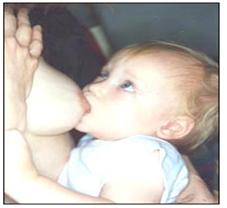
사진 4-3.젖 먹는 아기의 눈길을 보라! 엄마의 눈길과 아기의 눈길 접촉사랑을! 바로 이런 눈길 접촉사랑을 통해 모자간의 사랑의 반딩(Bonding)이 굳건히 형성된다. 이런 사랑의 반딩(Bonding)은 모유수유를 할 때 더 굳건히 형성된다.
Copyright ⓒ 2011 John Sangwon Lee, MD, FAAP
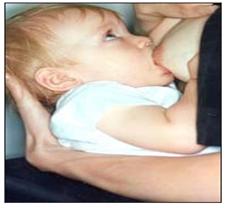
사진 4-4.젖 먹는 아기의 눈길을 보라! 엄마의 눈길과 아기의 눈길 접촉사랑을! 바로 이런 눈길 접촉사랑을 통해 모자간의 사랑의 반딩(Bonding)이 더 굳건히 형성된다.
Copyright ⓒ 2011 John Sangwon Lee, MD, FAAP
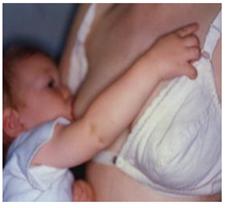
사진 4-5. 젖 먹는 아기의 신체적 접촉 사랑을 보라! 엄마의 신체와 아기 간 신체적 접촉사랑을! 바로 이런 신체적 접촉사랑을 통해 모자간의 사랑 반딩(Bonding)이 더 굳건히 형성된다.
Copyright ⓒ 2011 John Sangwon Lee, MD, FAAP
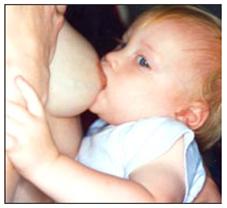
사진 4-6. 젖 먹는 아기의 신체적 접촉을 보라! 엄마의 신체와 아기의 신체적 접촉사랑을! 바로 이런 신체적 접촉사랑을 통해 모아간의 사랑 반딩(Bonding)이 더 굳건히 형성된다.
Copyright ⓒ 2011 John Sangwon Lee, MD, FAAP
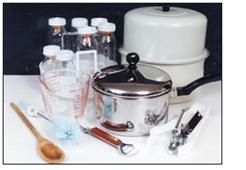
사진 4-7.인공영양을 먹이기 위해 필요로 하는 것들이 더 많이 있다
Copyright ⓒ 2011 John Sangwon Lee, MD, FAAP
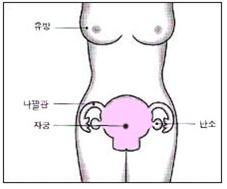
그림 4-1. 분만 후 모유수유를 하지 않는 산모의 자궁은 피토신 호르몬의 영향을 적게 받아 서서히 수축되고 서서히 회복된다.
Copyright ⓒ 2011 John Sangwon Lee, MD, FAAP
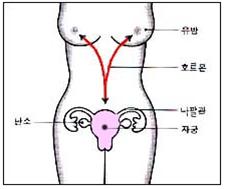
그림 4-2. 분만 후 모유수유를 하는 산모의 자궁은 피토신 호르몬의 영향을 받아 더 빨리 수축되고 회복된다.
Copyright ⓒ 2011 John Sangwon Lee, MD, FAAP
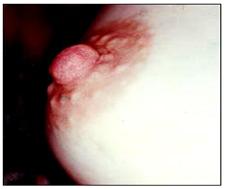
사진 4-8. 유두륜(유륜, 젖꼭지판)에 두드러지게 나온 여러 개의 작은 결절들이 있다. 그 결절들을 몽고메리 결절이라고 한다. 몽고메리 결절 속에 몽고메리 분비선이 있다. 거기에서 크림과 같은 윤활성 피지가 분비된다.
Copyright ⓒ 2011 John Sangwon Lee, MD, FAAP
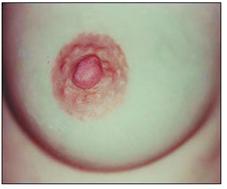
사진 4-9. 모유는 데우지 않아도 언제든지 먹을 수 있게 온도가 적절하다. 사진에서 유륜에 나있는 몽고메리 돌기 끝부분이 선명하게 보인다.
Copyright ⓒ 2011 John Sangwon Lee, MD, FAAP
Q.
임신하면 유방에도 변화가 온다고 하던데?
A.
- 임신이 되면 임신부의 신체에 많은 변화가 현저하게 생긴다.
- 그 중 더 특별하고 현저하게 생기는 신체적 변화는 자궁과 유방에 오는 변화이다.
- 장차 태어날 아기가 젖을 먹고 자라건 인공영양을 먹고 자라건 임신부는 장차 태어날 내 소중한 아기가 젖을 충분히 먹고 건강하게 자랄 수 있게 유방 속 포상샘과 젖 분비 세포 및 젖 분비선계가 발달된다.
- 유방 속에 유선관(포상샘 분비관계), 팽대부, 유관(젖샘 관) 등이 왕성하게 발달하고 젖꼭지가 커지고 유방 내 지방조직이 축적되고 유방 전체가 커진다.
- 유륜에 몽고메리선이 발달되어 거기서 피지가 생성되어 모유를 수유하기에 더 편리하게 유방 모든 것이 착착 진행된다.
- 유방이 탄탄하게 커지는 처음 얼마동안에는 좀 얼 얼거리고 아플 수 있다. 특히 유두가 어디에 닿으면 상당히 아플 수 있다.
- 한 개의 유방 안에는 15~20개의 유방 엽이 있다.
- 한 개의 유방 엽은 여러 개의 작은 유방 소엽들로 구성되어 있고,
- 유방 소엽들은 다시 더 세분된다.
- 그 유방소엽 속에 젖을 만드는 젖 세포들이 있다.
- 젖 세포들이 모여 젖선(포상샘)이 된다.
- 이 젖샘을 포상샘, 또는 유선이라고도 한다.
- 젖 선(腺)에서 만들어진 젖이 흘러가는 관을 포상샘 분비관이라 한다. 크고 작은 포상샘 분비관을 통틀어 포상샘 분비관계라고 한다. (그림 유방 참조)
- 아기가 젖꼭지를 빨아 먹기 전에 젖 선에서 분비된 젖이 괴여 있는 유방 속 동을 유동 또는 팽대부라고 한다. 임신이 되자마자 이런 유방 내부 젖분비선계의 조직이 점점 더 커지고 발달된다. 그리고 분만하기 바로 전까지 유방의 기능이 알게 모르게 더 활성화된다.
- 임신 중 태반에서 분비되는 항 프로택틴 호르몬(Antiprolactin hormone)의 작용으로 프로랙틴(Prolactin)이 포상샘의 젖 분비세포를 자극해서 젖이 분비되지 못하게 작용하고 있다가 아기가 태어난 후 태반이 자궁 속에서 배출 되자마자 프로랙틴이 젖분비 세포들을 자극하기 시작하고 젖분비 세포들이 젖을 만들기 시작한다. 그러나 프로랙틴이 분만 후 왕성하게 작용하기 시작하는 데는 1~2일의 시간이 필요하다.
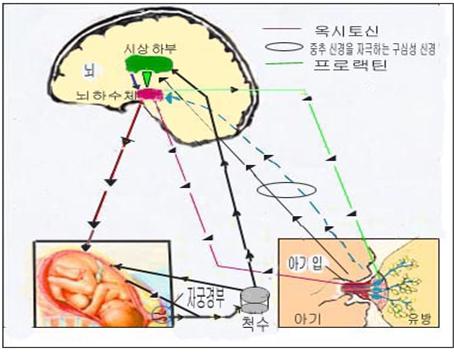
그림 4-3. 모유 분비, 자궁경관의 확장, 모유분비 자극 호르몬(프로랙틴), 유방의 유동 내로 모유를 분출시키는 옥시토신 호르몬, 젖꼭지를 빨 때 생길 수 있는 프로랙틴 호르몬 분비, 프로랙틴 분비 억제 호르몬
Copyright ⓒ 2011 John Sangwon Lee, MD, FAAP
Q. 유방은 어떻게 젖을 만들어내나?
A.
- 아기가 젖꼭지를 빨 때는 젖꼭지와 유륜 등에 있는 말초 신경이 자극 받는다. 이 때 아기가 젖을 빤다는 신호가 신경 임펄스(neural impulse)를 통해 수유모의 뇌에 있는 시상하부로 전달된다.
- 시상하부에서 신경 임펄스가 수유모의 뇌하수체의 후엽에 전달된다.
- 수유모의 뇌하수체 후엽에서 옥시토신(Oxytocin/pitocin)호르몬이 분비되고 그 옥시토신 호르몬은
- 포상샘 세포를 싸고 있는 근상피세포를 자극해서 모유가 포상샘 분비관으로 분비되게 한다.
- 유방 내 젖 세포에서 유방 젖 분비관계 속 유동 속으로 이미 분비되어 있는 모유가 포상샘 분비관계(유관) 등을 통해 젖꼭지 쪽으로 흘러나오도록 포상샘 분비관계를 자극한다.
- 그와 동시에 젖꼭지를 빨 때 생긴 신경 임펄스가 수유모의 시상하부로 전달되고 그 다음 뇌하수체 전엽에 전달된다.
- 프로랙틴(Prolactin)호르몬이 수유모의 뇌하수체의 전엽에서 분비된다. 그 프로랙틴 호르몬은 유방의 젖 분비세포(젖 세포)를 자극해 젖 분비를 촉진시킨다.
- 그와 동시에 유방 내 혈액 순환이 더 왕성해지고 유방 내 지방조직이 더 발달되고 지방이 유방 안에 더 축적된다.
- 유방의 피하 조직에 있는 정맥 혈관들이 유방 피부층을 통해 육안으로 쉽게 볼 수 있을 정도로 커진다.
- 임신 중 유방이 커지기 때문에 유방의 피부층에 신장반(임신선)이 생길 수 있다.
- 분만 후 아기가 젖을 빨 때 신경 임펄스가 시상하부로 전달되고 그 다음 뇌하수체 후엽으로 전달된다.
- 뇌하수체 후엽에서 옥시토신이 분비되어 모유가 분출된다. 임신 중에는 태반에서 분비되는 프로랙틴 분비 억제 호르몬에 의해서 아기가 태어나기 전에는 프로랙틴이 유방을 자극 할 수 없다.
- 모든 이런 생리를 배우다 보면 우리 몸의 생리는 컴퓨터 칩의 기능과 비슷하게 만들어 졌다고 생각 한다.
Q. 임신 중 젖꼭지와 유두륜에 크림 같은 것이 생기면 씻어내야 하나?
A.
- 임신 중 유두는 보통 때 크기의 배로 커지고 유두의 끝 부분에 15~20개 정도 젖나오는 구멍들이 있다.
- 유두의 뿌리의 주위에 있는 유륜(유두륜)의 크기도 배로 커진다. 유두와 유륜의 색은 짙은 흑갈색이거나 또는 진분홍색으로 변한다.
- 아마도 젖 먹는 아기가 육안으로 쉽게 보고 쉽게 찾을 수 있게 유두와 유륜의 색이 이렇게 변화된 것 같다.
- 유륜에는 몽고메리 결절이 여러 개 정상적으로 나있다. 그 몽고메리 결절 속에 몽고메리 선이 있고 거기에서 크림과 같은 윤활 피지가 분비돼 유륜과 유두를 부드럽게 해서 수유 중 유두와 유륜이 갈라지거나 터지지 않게 하는 역할을 한다.
- 즉 기계가 잘 돌아가도록 기계에 기름을 치는 것과 거의 같은 이치이다.
- 임신 기간 동안과 분만 후 모유수유하는 동안 윤활 피지는 유두와 유륜을 보호해 주는 역할을 한다.
- 몽고메리 선에서 분비된 크림 같은 윤활 피지를 비누로 씻어내서는 안 된다. 그리고 유두나 유륜에 국소 도포용 크림을 특별히 바를 필요도 없다.
Q. 유방의 크기가 작은 편인데 아기한테 충분한 양의 모유가 나올까?
A.
- 임신부에 따라 유방의 크기와 모양에 차이가 많다.
- 유방의 크기가 상당히 크던 작던 늘어졌던 탄탄하던 모든 산모의 유방은 한 아기 또는 두 아기가 동시 먹고 자랄 수 있도록 충분한 양의 모유를 분비할 수 있다.
- 소아청소년과 의사가 바라는 유방의 궁극적인 목적은 안정하고 편안한 느낌을 아기에게 주고 아기가 먹고 건강하게 자랄 수 있게 따뜻한 모유를 충분히 분비하는 것이다.
- 임신 5~6 개월경부터 유두에 있는 여러 개의 젖 구멍에서 맑은 젖이 몇 방울 정도 나올 수 있다. 이 젖은 초유의 일종이다. 이 젖은 마유라고도 한다.
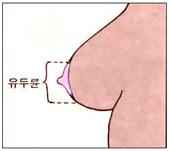
그림 4-4. 유방과 유두륜
Copyright ⓒ 2011 John Sangwon Lee, MD, FAAP
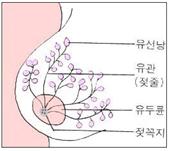
그림 4-5. 모유수유와 유방
Copyright ⓒ 2011 John Sangwon Lee, MD, FAAP
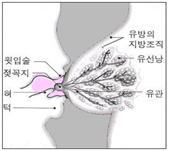
그림 4-6. 모유수유를 할 때 아기의 입과 유방과 젖꼭지의 상관관계도
Copyright ⓒ 2011 John Sangwon Lee, MD, FAAP
Frequent Q&A; on breastfeeding, anatomy of breasts, prolactin hormone 모유수유, 유방 구조, 모유수유 호르몬 프로랙틴에 관한 백문 백답,
| please see Chapter 1 |
The following is an example of a Q&A for health counseling for children and adolescents on the Internet about “breastfeeding, breast structure, and breastfeeding hormone prolactin”.
Q&A. Questions and Answers on Breastfeeding, Breast Structure, and Breastfeeding Hormone Prolactin-1
Q. What is breast?
A. The mammary gland/breast, or breast, is an exocrine gland that produces milk.
It is part of the female reproductive system.
The breast is located in the subcutaneous tissue of the forearm, between the 2nd and 6th ribs, the pectoralis major muscle, and between the sternum and the armpit.
The nipple is located in the center of the breast.
There is one nipple on each breast. The part of the skin surrounding the root of the nipple is called the areola, nipple plate, and also called the areola. Areola with Montgomery’s gland. This is where sebum is secreted. (See Figure 22-41)
Q. What is the internal structure of the breast?
There are 15-20 mammary gland lobes in one breast.
Each mammary lobe has many mammary glands (acinar/mammary glands).
The acinar gland is connected to the acinar glandular duct.
The acinar secretion duct is connected by an ampulla. The ampulla is again connected to the duct (mammary duct).
The duct is connected to the lactation hole of the nipple.
Milk comes out of the nipple hole (see picture breast)
Q. How is milk made in the breast?
When the baby sucks on the nipple and stimulates the areola → a nerve impulse is transmitted to the brain hypothalamus → the hypothalamus sends a signal to the posterior lobe of the pituitary gland to secrete oxytocin (Pitocin) → oxytocin stimulates the myoepithelium surrounding the acinar gland cells → milk (breast milk) is ejected from the acinar gland (mammary gland) → acinar gland secretion duct → ampulla → mammary gland duct (mammary gland tube) → nipple → milk is secreted through the nipple duct. Connective tissue and adipose tissue are located between each mammary gland lobe.
Q. How are breasts developed?
A.
• Until puberty, the structure of the breasts of boys and girls is almost the same.
• At the onset of puberty, female hormones called estrogen and progesterone are secreted by the corpus luteum of a woman’s ovaries.
• The mammary glands and acinar glands develop and grow. And adipose tissue accumulates in the breast. That is why the breasts of adolescent girls grow beautifully.

Photo 4-2. Raising a baby through breastfeeding is beneficial and has many benefits.
Physical contact love that occurs when the skin of the mother and the skin of the baby come into contact with each other during breastfeeding, in addition to being able to receive focused attention love, and care from the mother, is also beneficial to the baby and to the mother. They are just passing by without realizing that this fact exists.
A suckling baby may receive eye contact love from her mother and her mother may also receive eye contact love from her baby.
This love only happens to babies and nursing mothers who are breastfed while breastfeeding. Copyright ⓒ 2013 John Sangwon Lee, M.D. FAAP

Picture 4-3. Look into the eyes of a nursing baby! A mother’s eye and a baby’s eye contact love! Through this kind of eye-contact love, the bond of love between mother and child is firmly formed. This bond of love is formed stronger when breastfeeding. Copyright ⓒ 2011 John Sangwon Lee, MD., FAAP

Picture 4-4. Look into the eyes of a nursing baby!
A mother’s eye and a baby’s eye contact love! Through this kind of eye-contact love, the bond of love between mother and child is more firmly formed. Copyright ⓒ 2011 John Sangwon Lee, MD, FAAP

Photo 4-5. Behold the physical touch love of a suckling baby! Love of physical contact between the mother’s body and the baby! It is through this kind of physical contact love that the bond of love between mother and child is more firmly formed. Copyright ⓒ 2011 John Sangwon Lee, MD, FAAP

Photo 4-6. Look at the physical contact of a suckling baby! Love of mother’s body and baby’s physical contact! It is through this kind of physical contact love that the bond of love between Moa is more firmly formed. Copyright ⓒ 2011 John Sangwon Lee, MD., FAAP

Picture 4-7. There are more things you need to feed artificial nutrition. Copyright ⓒ 2011 John Sangwon Lee, MD., FAAP

Figure 4-1. After delivery, the uterus of non-breastfeeding mothers is less affected by the oxytocin hormone, and contracts slowly and recovers slowly. Copyright ⓒ 2011 John Sangwon Lee, MD., FAAP

Figure 4-2. After delivery, the uterus of breastfeeding mothers contracts and recovers faster under the influence of the oxytocin hormone. Copyright ⓒ 2011 John Sangwon Lee, MD., FAAP

Photo 4-8. There are several small nodules prominent on the areola (nipple plate). These nodules are called Montgomery nodules. Montgomery’s nodule contains Montgomery’s glands. From there, a lubricating oil like cream is secreted. Copyright ⓒ 2011 John Sangwon Lee, MD, FAAP

Photo 4-9. The temperature is appropriate for breast milk to be eaten at any time without reheating it. In the photo, the tip of the Montgomery process on the areola is clearly visible. Copyright ⓒ 2011 John Sangwon Lee, MD, FAAP
Q. Did you know that your breasts change when you are pregnant?
A.
• When you become pregnant, many changes occur in the body of a pregnant woman.
• The more special and notable physical changes are those in the uterus and breasts.
• Whether the baby to be born is fed with breast milk or fed with artificial nutrition, pregnant women develop acinar glands, lactating cells and lactation system in the breast so that their precious baby can get enough milk and grow up healthy.
• Mammary gland ducts (acinar glands), ampulla, and ducts (mammary gland ducts) develop vigorously in the breast, and the nipples enlarge, the fat tissue in the breast accumulates, and the entire breast enlarges.
• Montgomery’s gland is developed in the areola, and sebum is produced there, making it more convenient for breastfeeding.
• During the first few days as your breasts are getting firmer, you may feel a little tingly and sore. It can be quite painful, especially if it touches the nipple.
• There are 15-20 mammary lobes in one breast.
• A breast lobe consists of several small breast lobules,
• Breast lobules are further subdivided.
• Inside the breast lobules are the milk cells that make milk.
• Milk cells gather to form mammary glands (acinar glands).
• These mammary glands are also called acinar or mammary glands.
• The ducts through which milk is made from the mammary glands are called acinar glands. The large and small acinar glands are collectively called acinar glandular glands. (see picture breast)
• Before the baby sucks on the nipple, the sinuses in the breast, where the milk secreted from the mammary glands is stagnant, is called a bulge or ampulla. As soon as you get pregnant, these tissues of the lactation system inside the breast grow larger and develop. And just before delivery, the function of the breast is more activated without realizing it.
• During pregnancy, due to the action of the antiprolactin hormone secreted by the placenta, prolactin stimulates the lactating cells of the acinar gland to prevent lactation. As soon as it is excreted, prolactin begins to stimulate the lactating cells and the lactating cells begin to produce milk. However, it takes 1 to 2 days for prolactin to start working vigorously after delivery.

Figure 4-3. Breast milk secretion, dilatation of the cervix, lactation stimulating hormone (prolactin), oxytocin hormone that releases milk into the flow of breasts, prolactin secretion that may occur during nipple sucking, prolactin secretion inhibitory hormone Copyright ⓒ 2011 John Sangwon Lee, MD, FAAP
Q. How does the breast produce milk?
A.
• When a baby sucks on the nipple, peripheral nerves in the nipple and areola are stimulated. At this time, a signal that the baby is suckling is transmitted to the hypothalamus in the mother’s brain through a neural impulse.
• In the hypothalamus, nerve impulses are transmitted to the posterior lobe of the pituitary gland of the nursing mother.
• Oxytocin/pitocin hormone is secreted from the posterior pituitary of a nursing mother, and the oxytocin hormone is
• Stimulates the myoepithelial cells surrounding the acinar cells, allowing milk to be secreted into the acinar glandular ducts.
• Stimulates the acinar gland secretion system so that the milk already secreted from the mammary gland cells in the breast into the flow in the mammary gland system flows toward the nipple through the acinar gland secretion system (ducts).
• At the same time, the nerve impulse generated during nipple sucking is transmitted to the hypothalamus of the nursing mother and then to the anterior pituitary gland.
• Prolactin hormone is secreted from the anterior lobe of the pituitary gland of a nursing mother. The prolactin hormone stimulates the lactation cells (milk cells) of the breast to promote lactation.
• At the same time, blood circulation in the breast becomes stronger, the fat tissue in the breast develops more and more fat accumulates in the breast.
• Vein vessels in the subcutaneous tissue of the breast become large enough to be easily visible to the naked eye through the breast skin layer.
• Because the breasts enlarge during pregnancy, pregnancy glands may form in the skin layer of the breast.
• When the baby sucks after delivery, nerve impulses are transmitted to the hypothalamus and then to the posterior pituitary gland.
• Oxytocin is secreted from the posterior pituitary gland to produce milk. During pregnancy, prolactin cannot stimulate the breast until the baby is born due to the hormone that inhibits the secretion of prolactin secreted by the placenta.
• If you learn all these physiology, you think that our body’s physiology is made similar to the function of a computer chip.
Q. If I get creamy things on my nipples and nipples during pregnancy, should I wash them off?
A.
• During pregnancy, the nipples grow to twice their normal size and there are 15-20 milky holes at the tip of the nipple.
• The size of the areola around the root of the nipple is also doubled. The color of the nipples and areolas changes to dark brown or dark pink.
• It is likely that the nipples and areolas have been changed in color so that the suckling baby can easily see and find them with the naked eye.
• Areola has several Montgomery nodules normally. There is a Montgomery gland in the Montgomery tubercle, and a cream-like lubricating oil is secreted from it to soften the areola and nipples so that the nipples and areolas do not crack or burst during lactation.
• In other words, it is almost the same as applying oil to the machine to make it run well.
• Lubricating sebum protects the nipples and areolas during pregnancy and during breastfeeding after delivery.
• Do not wash off with soap the creamy lubricating sebum secreted by the Montgomery gland. And there is no need to apply a special topical cream to the nipples or areolas.
Q. I have small breasts, will my baby produce enough milk?
A.
• There are many differences in the size and shape of breasts depending on the pregnant woman.
• All mothers’ breasts, whether large or small, or loose and firm, can secrete enough milk to feed and grow one or two babies at the same time.
• The ultimate goal of breasts desired by pediatricians is to give the baby a feeling of stability and comfort and to secrete enough warm milk so that the baby can eat and grow up healthy.
• From around the 5th to 6th month of pregnancy, a few drops of clear milk may come out of the multiple milk holes in the nipple. This is a kind of wet colostrum.

Figure 4-4. breast and nipple. Copyright ⓒ 2011 John Sangwon Lee, MD, FAAP

Figure 4-5. breastfeeding and breast. Copyright ⓒ 2011 John Sangwon Lee, MD, FAAP

Figure 4-6. The relationship between the baby’s mouth, breast, and nipple when breastfeeding Copyright ⓒ 2011 John Sangwon Lee, MD, FAAP
참조문헌 및 출처
- NelsonTextbook of Pediatrics 22ND Ed
- The Harriet Lane Handbook 22ND Ed
- Growth and development of the children
- Red Book 32nd Ed 2021-2024
Copyright ⓒ 2015 John Sangwon Lee, MD, FAAP 미국 소아과 전문의, 한국 소아청소년과 전문의 이상원 저 “부모도 반의사가 되어야 한다”-내용은 여러분들의 의사로부터 얻은 정보와 진료를 대신할 수 없습니다. “The information contained in this publication should not be used as a substitute for the medical care and advice of your doctor. There may be variations in treatment that your doctor may recommend based on individual facts and circumstances. “Parental education is the best medicine.” |